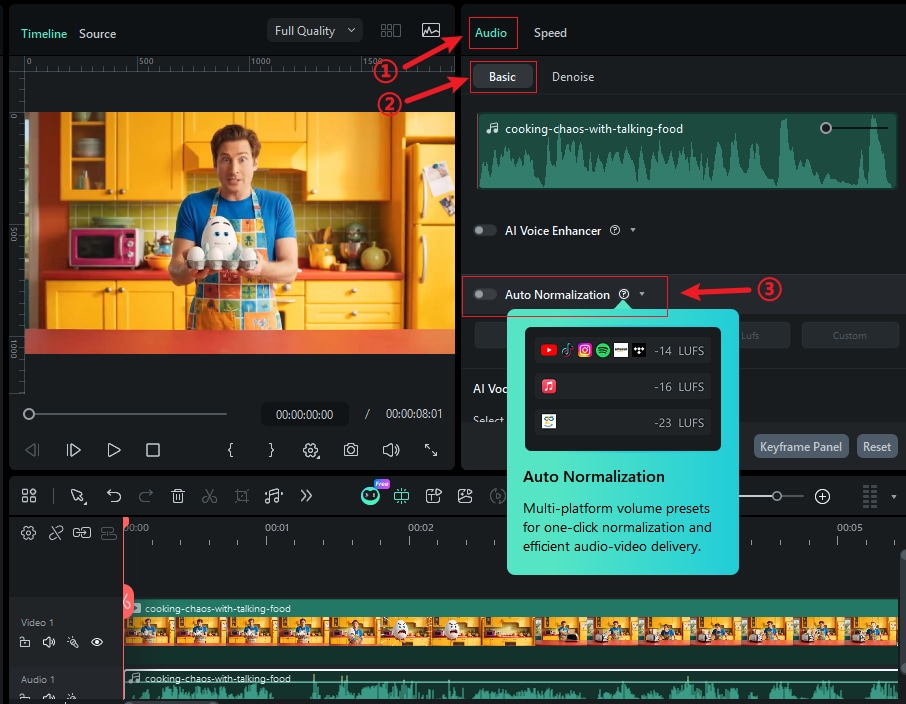For the Best Results, Use the Latest Version.
-
Preparations
-
Account
-
Get Started & Basic Settings
-
Compatibility & Tech Specs
-
Performance Settings
-
-
Creating Projects
-
Creating New Projects
-
-
Importing & Recording
-
Video Editing for Windows
-
Basic Video Editing
- Enable/Disable Clip in Windows
- Magnetic Timeline for Windows
- Dual Monitor Setup for Video Editing on Windows
- Select All Clips on Timeline for Windows
- Manage Timeline and Tracks on Windows
- Auto Ripple for Windows
- Split & trim video
- Crop & Pan & Zoom Video
- Compositing
- Change video playback speed
- Playing videos in reverse
- Mark In and Mark Out for Windows
- Markers for Windows
- Group editing
- Customizable Backgrounds for Videos and Images in Windows
- Video snapshot
- Using freeze frame
- Logo Reveal For Windows
- Apply auto enhance
- Applying drop shadow
- Adjustment layer for Windows
- Transforming
- Video Editing Ruler – Windows
-
Advanced Video Editing
-
AI-Powered Video Editing
- Smart Scene Cut for Windows
- Smart Short Clips for Windows
- AI Face Mosaic for Windows
- AI Video Enhancer for Windows
- AI Text-to-Video for Windows
- Planar Tracking for Windows
- AI Idea to Video for Windows
- Filmora Image to Video for Windows
- Instant Cutter Tool for Windows
- AI Extend
- AI Script to Video Guide for Windows
- AI Text-Based Editing for Windows
- AI Mate Editing for Windows
- Create with instant mode
- ChatGPT Plugin - AI Copywriting
- AI Smart Cutout
- Lens correction on Windows
- Auto reframe video
- AI Portrait Cutout
- Scene detection feature
- AI Smart Masking for Windows
- Make motion tracking
- Video Stabilization for Windows
- AI Video/Photo Object Remover for Windows
- AI Smart Search for Windows
- AI Skin Tone Protection for Windows
- AI Image for Windows
- Chroma key (green screen)
- Super Slow Motion with Optical Flow for Windows
- Video Denoise for Windows
-
-
Audio Editing for Windows
-
Basic Audio Editing
-
Advanced Audio Editing
-
AI-Powered Audio Editing
-
-
Text Editing for Windows
-
Basic Text Editing
-
Advanced Text Editing
-
AI-Powered Text Editing
-
-
Video Customizations
-
Video Effects
-
Audio Effects
-
Transitions
-
Stickers
-
Filters
-
Color Editing
-
Animations
-
Templates
-
Asset Center
-
-
Exporting & Share & Cloud Backup
Auto Normalization
The Auto Normalization feature analyzes the loudness of selected audio clips and adjusts them to meet different platform standards (LUFS/LKFS). This ensures your content complies with broadcasting requirements whether you're publishing to YouTube, streaming services, or traditional broadcast platforms. You can choose from preset options or set custom loudness values.
Index
Access Auto Normalization
1 Click on the audio clip in the timeline that you want to normalize.
2 In the upper-right audio settings panel, navigate to Audio > Basic.
3 Locate the Auto Normalization option in the Basic audio settings.

Choose Platform Presets
Once you enable Auto Normalization, you'll see preset options designed for different platforms and broadcasting standards:
1 -23 LUFS: European broadcasting standard (EBU R128), ideal for traditional TV and radio.
2 -16 LUFS: Streaming platforms standard, perfect for YouTube, Netflix, and online video content.
3 -14 LUFS: Music streaming services standard, suitable for Spotify, Apple Music, and similar platforms.

Set Custom Loudness Values
For specific requirements or unique broadcasting standards, you can set custom LUFS values:
1 Click the Custom button to enable manual adjustment.
2 Use the LUFS slider to adjust the loudness level, or input a specific value.
3 The range typically allows adjustments from -23 LUFS to -10 LUFS for maximum flexibility.

Apply and Reset Settings
After selecting your desired loudness standard:
1 Click the Apply button to process the audio normalization.
2 Filmora will analyze and adjust the selected audio clip(s) automatically.
3 To reset the normalization, toggle the Auto Normalization switch off, or click the reset icon.

Note:
- Auto Normalization works on both audio and video clips with audio tracks.
- The feature analyzes the entire duration of the selected clip to determine optimal loudness adjustment.
- Clicking the RESET button in the Audio editing panel will reset all audio editing settings.
Related Posts
Featured Articles
The 9 Best Apps for Making and Editing Instagram Reels [2025]
Ready to create outstanding Instagram Reels? Explore the best Reels maker apps to transform your creations.
How to Remove Echo from Audio: 3 Easy and Proven Ways
Are you looking to remove echo and other background noise from your audio? Here are three ways you to accurately remove echo from audio in minutes.
How to Change Colors in Adobe After Effects?
The best part is that you don't have to be a video editing wizard in order to change a color of a background layer or an entire area of a shot, so in this article, we are going to take you through sev
Recommended User Guide
Access Audio Meter in Windows
The Audio Meter is an independent functionality in Filmora, and users can enable it during or after editing.
Auto Normalization for Mac
Learn to set auto normalization in Filmora Mac
